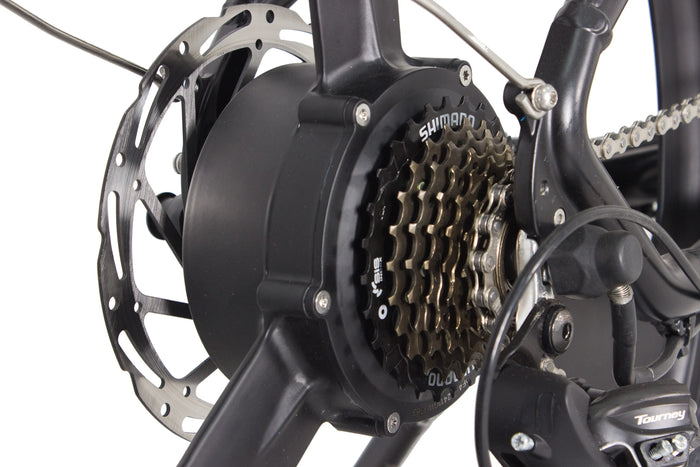Choosing between hub-drive and mid-drive motors impacts your e-bike’s performance, cost, and terrain capability. Here’s a data-backed breakdown to help you decide, including insights from technical experts and real-world riders.
Hub-Drive Motors: Simplicity & Affordability
How They Work:
- Mounted in the front or rear wheel hub.
- Directly powers the wheel, independent of gears.
Pros:
- Lower Cost: Entry-level e-bikes and conversion kits start at $300–$600.
- Low Maintenance: Minimal strain on drivetrain components (chain, cassette).
- Quiet Operation: Smooth power delivery for urban commutes.
- Easy Installation: DIY-friendly for retrofitting standard bikes.
Cons:
- Hill Struggles: Limited torque (40–60 Nm*) and efficiency on steep inclines.
- Weight Distribution: Motor weight in the wheel can affect handling, especially in front hubs.
* Nm stands for Newton-meter, the unit of measurement for torque (rotational force). In the context of e-bike motors:
-
40–60 Nm: Moderate torque, suitable for flat terrain and light hills.
-
60–120 Nm: High torque, ideal for steep climbs, off-road trails, and heavy loads.
-
The higher the Nm, the more powerful the motor feels when accelerating or climbing.
Real-World Rider Feedback (Reddit Insights):
- "Hub motors are great for flat commutes, but they burn through battery on hills."
- "Rear hubs offer better traction than front hubs on wet roads."
Mid-Drive Motors: Power & Precision
How They Work:
- Centered near the pedals, powering the bike through the chain and gears.
Pros:
- Hill Dominance: High torque (60–120 Nm) leverages gears for steep climbs.
- Battery Efficiency: 20–30% longer range on mixed terrain due to optimized gear use.
- Balanced Handling: Central weight improves stability on trails.
- Natural Feel: Power syncs with pedaling for a seamless ride.
Cons:
- Higher Cost: Premium e-bikes and kits start at $1,500–$4,000+.
- Drivetrain Wear: Chains and cassettes wear 2–3x faster under high torque.
Technical Data (Industry Benchmarks):
- Mid-drives maintain efficiency on 15%+ inclines, while hub motors lose 40%+ power.
- Mid-drives reduce battery drain by 15–25% on hilly routes compared to hubs.
Key Comparisons: Hub vs. Mid-Drive
|
Factor |
Hub-Drive |
Mid-Drive |
|
Torque |
40–60 Nm |
60–120 Nm |
|
Hill Performance |
Struggles >10% incline |
Excels on 20%+ inclines |
|
Battery Range |
25–50 miles (flat terrain) |
40–70 miles (mixed terrain) |
|
Maintenance Cost |
50–100/year |
150–300/year (drivetrain wear) |
|
Best For |
City commuting, flat trails |
Mountain biking, touring, hills |
Real-World Scenarios
1. Urban Commuting:
- Hub-Drive: Ideal for stop-and-go traffic. Minimal maintenance, affordable.
- Mid-Drive: Overkill unless tackling bridges or hilly cities.
2. Mountain Biking:
- Mid-Drive: Tackles rocks, roots, and 25%+ grades with ease.
- Hub-Drive: Overheats on sustained climbs; limited traction.
- Mid-Drive: Efficient gear use extends range.
- Hub-Drive: Requires carrying spare batteries for hilly routes.
What Riders Are Saying (Reddit Highlights):
- "Mid-drives feel like riding a regular bike but with superhuman legs."
- "Hub motors are bulletproof for daily commutes—just avoid steep hills."
- "Mid-drive maintenance is pricey, but worth it for trail performance."
Durability & Longevity
- Hub Motors: Last 8,000–15,000 miles with minimal care.
- Mid-Drive Motors: Last 10,000–20,000 miles but require frequent chain replacements (every 1,000–2,000 miles).
Cost Breakdown
|
Expense |
Hub-Drive |
Mid-Drive |
|
Upfront Cost |
300–1,500 |
1,500–4,000+ |
|
Annual Maintenance |
50–100 |
150–300 |
|
Battery Replacement |
300–600 (every 3–5 years) |
Same |
Final Decision Guide
1. Budget <$1,500 + Flat Terrain → Hub-Drive.
2. Frequent Hills/Off-Road + Budget >$2,000 → Mid-Drive.
3. DIY Enthusiasts → Hub-Drive conversion kits.
4. Performance Riders → Mid-Drive for torque and efficiency.
Still Unsure? Test ride both! Hub-drives win for simplicity, while mid-drives excel where power and terrain matter. Your riding style decides the winner.
Data sources: Technical benchmarks from industry studies, rider testimonials from forums.


